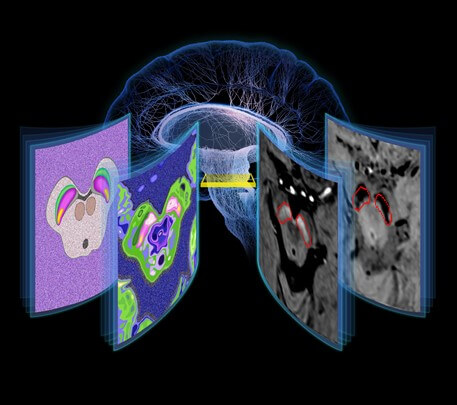
Imaging iron and neuromelanin simultaneously using a single 3D gradient echo magnetization transfer sequence: Combining neuromelanin, iron and the nigrosome-1 sign as complementary imaging biomarkers in early stage Parkinson’s disease
By: Karen Holzberger, President & CEO of SpinTech MRI
Author(s): Naying He a,+,∗ , Kiarash Ghassabanb,c,+, Pei Huang d,+, Mojtaba Jokar e , Ying Wang b,e , Zenghui Chenga , Zhijia Jina , Yan Li a , Sean K. Sethi b,e , Yixi He d , Yongsheng Chenf , Sara Gharabaghi e , Shengdi Chend,∗ , Fuhua Yana,∗ , E. Mark Haacke
Journal: NeuroImage
Published: 2021
Read Full Paper: https://www.sciencedirect.com/science/article/pii/S1053811921000872?via%3Dihub
Abstract

Diagnosing early stage Parkinson’s disease (PD) is still a clinical challenge. Previous studies using iron, neuromelanin (NM) or the Nigrosome-1 (N1) sign in the substantia nigra (SN) by themselves have been unable to provide sufficiently high diagnostic performance for these methods to be adopted clinically.
Our goal in this study was to extract the NM complex volume, iron content and volume representing the entire SN, and the N1 sign as potential complementary imaging biomarkers using a single 3D magnetization transfer contrast (MTC) gradient echo sequence and to evaluate their diagnostic performance and clinical correlations in early stage PD.
Method
A total of 40 early stage idiopathic PD subjects and 40 age- and sex-matched healthy controls (HCs) were imaged at 3T. NM boundaries (representing the SN pars compacta (SNpc) and parabrachial pigmented nucleus) and iron boundaries representing the total SN (SNpc and SN pars reticulata) were determined semi-automatically using a dynamic programming (DP) boundary detection algorithm. Receiver operating characteristic analyses were performed to evaluate the utility of these imaging biomarkers in diagnosing early stage PD. A correlation analysis was used to study the relationship between these imaging measures and the clinical scales. We also introduced the concept of NM and total iron overlap volumes to demonstrate the loss of NM relative to the iron containing SN. Furthermore, all 80 cases were evaluated for the N1 sign independently.
Results
The NM and SN volumes were lower while the iron content was higher in the SN for PD subjects compared to HCs. Interestingly, the PD subjects with bilateral loss of the N1 sign had the highest iron content. The area under the curve (AUC) values for the average of both hemispheres for single measures were: .960 for NM complex volume; .788 for total SN volume; .740 for SN iron content and .891 for the N1 sign. Combining NM complex volume with each of the following measures through binary logistic regression led to AUC values for the averaged right and left sides of: .976 for total iron content; .969 for total SN volume, .965 for overlap volume and .983 for the N1 sign. We found a negative correlation between SN volume and UPDRS-III (R2 = .22, p = .002). While the N1 sign performed well, it does not contain any information about iron content or NM quantitatively, therefore, marrying this sign with the NM and iron measures provides a better physiological explanation of what is happening when the N1 sign disappears in PD subjects.
Conclusions
In summary, the combination of NM complex volume, SN volume, iron content and the N1 sign as derived from a single MTC sequence provides complementary information for understanding and diagnosing early stage PD.

